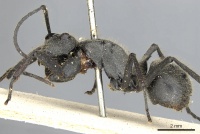Polyrhachis rixosa
| Polyrhachis rixosa | |
|---|---|

| |
| Scientific classification | |
| Kingdom: | Animalia |
| Phylum: | Arthropoda |
| Class: | Insecta |
| Order: | Hymenoptera |
| Family: | Formicidae |
| Subfamily: | Formicinae |
| Tribe: | Camponotini |
| Genus: | Polyrhachis |
| Subgenus: | Myrma |
| Species: | P. rixosa |
| Binomial name | |
| Polyrhachis rixosa Smith, F., 1858 | |
| Synonyms | |
| |
Specimens have been collected from a range of lowland Sulawesi forest habitats from 100 - 600 m.
Identification
A member of the Polyrhachis relucens species group in the subgenus Myrma .
Keys including this Species
Distribution
Latitudinal Distribution Pattern
Latitudinal Range: 4.533333333° to -1.25°.
| North Temperate |
North Subtropical |
Tropical | South Subtropical |
South Temperate |
- Source: AntMaps
Distribution based on Regional Taxon Lists
Indo-Australian Region: Borneo, Indonesia (type locality), Malaysia, Philippines, Sulawesi.
Oriental Region: Thailand.
Distribution based on AntMaps
Distribution based on AntWeb specimens
Check data from AntWeb
Countries Occupied
| Number of countries occupied by this species based on AntWiki Regional Taxon Lists. In general, fewer countries occupied indicates a narrower range, while more countries indicates a more widespread species. |

|
Estimated Abundance
| Relative abundance based on number of AntMaps records per species (this species within the purple bar). Fewer records (to the left) indicates a less abundant/encountered species while more records (to the right) indicates more abundant/encountered species. |

|
Biology
Castes
Queen
Images from AntWeb
   
| |
| Holotype of Polyrhachis rixosa. Queen (alate/dealate). Specimen code casent0903447. Photographer Z. Lieberman, uploaded by California Academy of Sciences. | Owned by NHMUK, London, UK. |
Nomenclature
The following information is derived from Barry Bolton's Online Catalogue of the Ants of the World.
- rixosa. Polyrhachis rixosus Smith, F. 1858b: 68 (q.) INDONESIA (Sulawesi). Combination in P. (Myrma): Emery, 1925b: 202. Senior synonym of lycidas: Kohout, 1998: 523.
- lycidas. Polyrhachis lycidas Smith, F. 1861b: 43, pl. 1, fig. 23 (w.) INDONESIA (Sulawesi). Mayr, 1867a: 58 (q.). Combination in P. (Myrma): Wheeler, W.M. 1919e: 123. Junior synonym of rixosa: Kohout, 1998: 523.
Unless otherwise noted the text for the remainder of this section is reported from the publication that includes the original description.
Description
Type Material
Kohout (2008) - Holotype queen. INDONESIA, SULAWESI, The Natural History Museum (examined).
The following notes on F. Smith type specimens have been provided by Barry Bolton (details):
Polyrhachis lycidas
Holotype worker in Oxford University Museum of Natural History. Labelled “Tond.” (= Tondano, Sulawesi) and with a Donisthorpe type-label.
References
- Emery, C. 1925d. Hymenoptera. Fam. Formicidae. Subfam. Formicinae. Genera Insectorum 183: 1-302 (page 202, Combination in P. (Myrma))
- Khachonpisitsak, S., Yamane, S., Sriwichai, P., Jaitrong, W. 2020. An updated checklist of the ants of Thailand (Hymenoptera, Formicidae). ZooKeys 998, 1–182 (doi:10.3897/zookeys.998.54902).
- Kohout, R. J. 1998. New synonyms and nomenclatural changes in the ant genus Polyrhachis Fr. Smith (Hymenoptera: Formicidae: Formicinae). Mem. Qld. Mus. 42: 505-531 (page 523, Senior synonym of lycidas)
- Kohout, R.J. 2008a. A review of the Polyrhachis ants of Sulawesi with keys and descriptions of new species (Hymenoptera: Formicidae: Formicinae). Memoirs of the Queensland Museum. 52:255-317.
- Smith, F. 1858b. Catalogue of hymenopterous insects in the collection of the British Museum. Part VI. Formicidae. London: British Museum, 216 pp. (page 68, queen described)
References based on Global Ant Biodiversity Informatics
- Andersen A. N., R. J. Kohout, and C. R. Trainor. 2013. Biogeography of Timor and Surrounding Wallacean Islands: Endemism in Ants of the Genus Polyrhachis Fr. Smith. Diversity 5: 139-148.
- Chapman, J. W., and Capco, S. R. 1951. Check list of the ants (Hymenoptera: Formicidae) of Asia. Monogr. Inst. Sci. Technol. Manila 1: 1-327
- Davidson D. W., S. C. Cook, R. R. Snelling and T. H. Chua. 2003. Explaining the Abundance of Ants in Lowland Tropical Rainforest Canopies. Science 300: 969-972.
- Emery C. 1886. Saggio di un catalogo sistematico dei generi Camponotus, Polyrhachis e affini. Memorie della Reale Accademia delle Scienze dell'Istituto di Bologna 5: 363-382
- Emery C. 1901. Formiciden von Celebes. Zoologische Jahrbücher. Abteilung für Systematik, Geographie und Biologie der Tiere 14:565-580.
- Hashimoto Y., and S. Yamane. 2014. Comparison of foraging habits between four sympatric army ant species of the genus Aenictus in Sarawak, Borneo. Asian Myrmecology 6: 95-104.
- Jaitrong W.; Nabhitabhata, J. 2005. A list of known ant species of Thailand. The Thailand Natural History Museum Journal 1(1): 9-54.
- Kohout R. J. 1998. New synonyms and nomenclatural changes in the ant genus Polyrhachis Fr. Smith (Hymenoptera: Formicidae: Formicinae). Memoirs of the Queensland Museum 42: 505-531
- Kohout R.J. 2008. A new Polyrhachis (Myrma) vestita-group species from Sulawesi. Zoologische Mededeelingen, Leiden 82: 297-302.
- Kohout, R. J. 2008. A review of the Polyrhachis ants of Sulawesi with keys and descriptions of new species (Hymenoptera: Formicidae: Formicinae). Memoirs of the Queensland Museum 52:255-317.
- Pfeiffer M.; Mezger, D.; Hosoishi, S.; Bakhtiar, E. Y.; Kohout, R. J. 2011. The Formicidae of Borneo (Insecta: Hymenoptera): a preliminary species list. Asian Myrmecology 4:9-58
- Robson Simon Database Polyrhachis -05 Sept 2014
- Smith F. 1861. Catalogue of hymenopterous insects collected by Mr. A. R. Wallace in the islands of Ceram, Celebes, Ternate, and Gilolo. [part]. Journal and Proceedings of the Linnean Society of London. Zoology 6: 36-48.
- Tanaka H. O., S. Yamane, and T. Itioka. 2012. Effects of a fern-dwelling ant species, Crematogaster difformis, on the ant assemblages of emergent trees in a Bornean tropical rainforest. Ann. Entomol. Soc. Am. 105(4): 592-598.
- Wheeler W. M. 1919. The ants of Borneo. Bulletin of the Museum of Comparative Zoology 63:43-147.
- Yamane S.; Nona, A. R. 1994. Ants from Lambir Hills National Park, Sarawak. Pp. 222-226 in: Inoue, T.; Hamid, A. A. (eds.) 1994. Plant reproductive systems and animal seasonal dynamics. Long-term study of dipterocarp forests in Sarawak. Kyoto: Center for Ecological Research, Kyoto University, vii + 255 pp.

